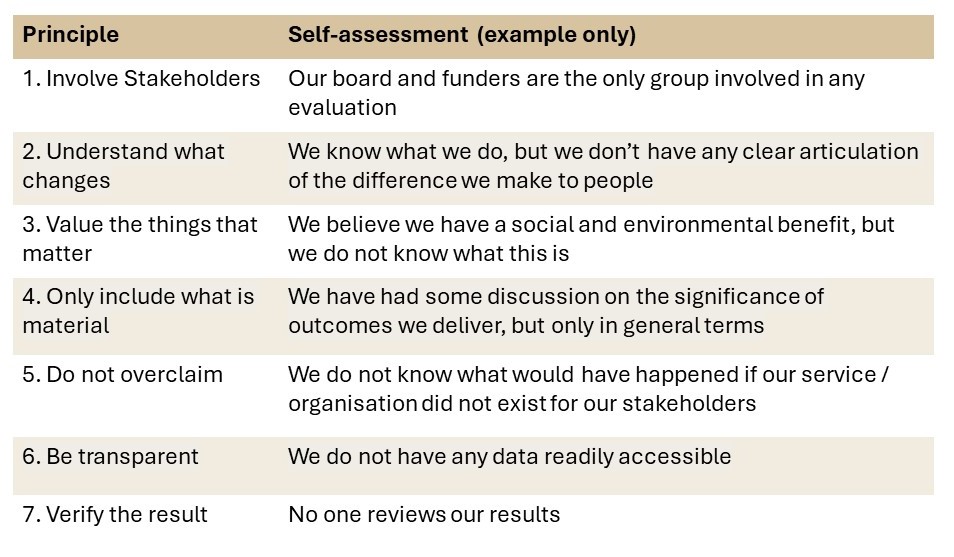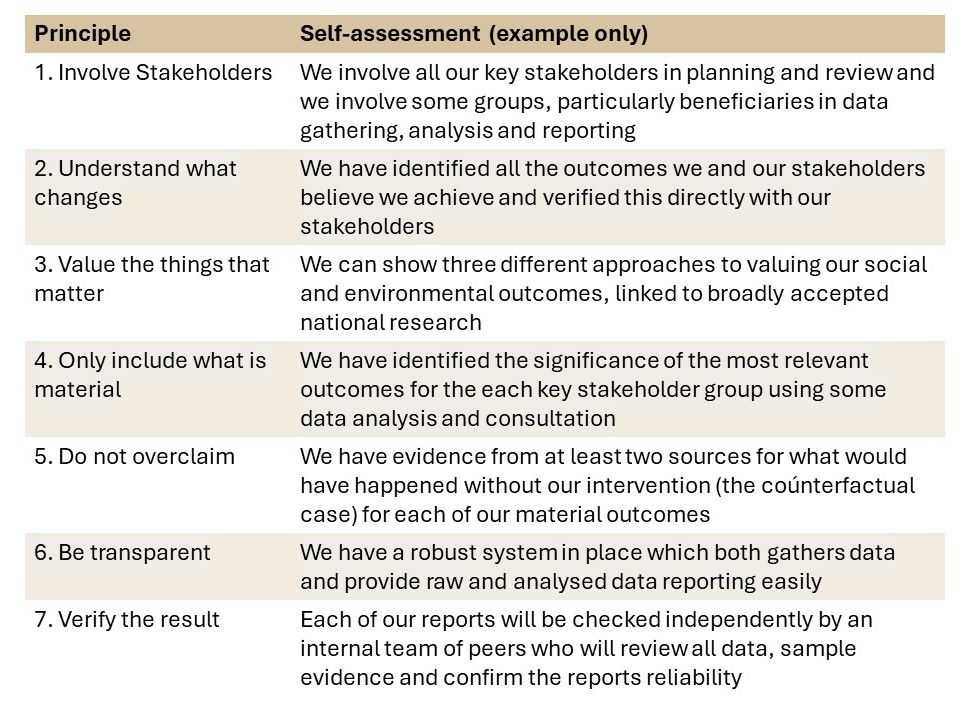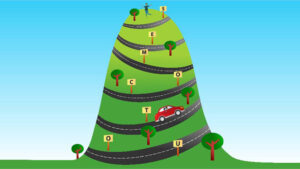
Getting the most out of SROI
A full Social Return on Investment (SROI) report isn’t the only way to benefit from applying the SROI framework.

- A full SROI analysis and report has its place, however it is not the only way to reap the benefits of the SROI framework.
- Different parts of the SROI framework can be applied to understand the effectiveness and efficiency of a program or organisation and to support decision-making.
- There is a shift towards using the SROI framework as an ongoing measurement framework rather than as a one-off evaluation.
Different parts of the SROI framework can be applied to understand the effectiveness and efficiency of any investment, program or organisation – without doing a full SROI report.
In this article we outline some of the ways that the SROI framework and the principles of SROI have been used by our clients to support their decision-making without – necessarily – doing a full SROI analysis. We also identify the encouraging trend away from using the SROI framework as a one-off evaluation towards using it as an ongoing measurement framework.
We consider:
- How to ensure that SROI is the right approach for your organisation’s circumstances
- Using the SROI framework to develop an hypothesis on impact
- Ensuring that you focus your effort in the right places
- Using the SROI framework as a measurement tool to underpin continuous improvement.
Ensuring that SROI is the right approach for your situation
Applying the SROI framework is no different from any other management and reporting framework. With this in mind, there are three overarching questions to answer before you begin your SROI journey:
- Purpose: What is the reason for doing this piece of work?
- Audience: Who do I need to share this work with or convince?
- Rigour: How far do I need to go to get a meaningful answer?
There are no right or wrong answers to these questions, and the answers are likely to change over time. Even if you are clear that an evaluation project is required, an organisation at the start-up phase with a new program may answer the questions in the following way:
- Purpose: develop compelling evidence that the program is working, to attract further investment in the organisation
- Audience: current management committee and prospective funders
- Rigour: sufficient rigour to give prospective funders confidence that a new program warrants investment
In this case an SROI project may be appropriate to achieve the level of rigour required to support management in attracting new investors.
Asking these questions upfront can help you decide whether you should conduct a full SROI analysis, or whether you are better placed to approach SROI in stages. ”
Contrast this example with an organisation that has been running a successful program in one location for 10 years, but now wants to replicate the program in other comparable locations. Their answers to the three questions may be:
- Purpose: understand why the program works, to inform the replication of the program in other locations
- Audience: the Executive and Board, and potentially prospective funders
- Rigour: sufficient rigour to prove that the evidence they have is compelling and suggests that there is a strong relationship between the activity and the desired outcomes
This example may warrant a robust and rigorous evaluation from an independent third party. SROI might still be the right framework, but the approach will be deeper, and the standard of evidence will be higher.
We are frequently asked to advise on the level of detail, or the analytic rigour required in an SROI or other evaluation. The investment in SROI, or in measurement and evaluation systems, should be proportionate with the funds at risk or the amount of investment being sought.
Asking these questions upfront can help you decide whether you should conduct a full SROI analysis, or whether you are better placed to approach SROI in stages. There are ways to use the SROI framework without doing a full analysis, or that can be used as a ‘soft entry’ into the SROI process.
Using the SROI framework to develop an hypothesis on impact
Once you have an idea about the purpose of your work, your audience and how rigorous you need to be, you can use the SROI framework to develop an hypothesis on the impact of your program. This may be an end in itself, or it may be a ‘soft entry’ to the SROI process. SVA Consulting always works on developing an hypothesis with clients before we embark on a full SROI project.
SROI is a framework for accounting for value. There are five simple questions at the heart of SROI:
- Who is changed?
- How do they change?
- How do you know that they have changed?
- How important are the changes?
- How much is as a result of you?
If you know your audience, purpose and the rigour required, then you can start to answer these five questions in a way that ultimately helps you to understand if you are doing good.
These conversations always cut to the heart of why your organisation exists… ”
Often there is a champion (it could be a board member, CEO, or program staff) within an organisation who wants to understand whether the work of their organisation is making a difference and creating value. Whenever we have our first conversation with a prospective client about SROI, these five questions form the basis of our initial discussions with them.
For organisations that are starting out on SROI, this initial conversation is a spark that often results in further conversations within the organisation that create a greater awareness about what is not known, and options for how to address the lack of information about what matters most (i.e. the changes for the people they serve).
Whether you are starting out, or believe you can do a full SROI analysis, a first step should be a management or board meeting where you have a first pass at answering the five questions collectively. These conversations always cut to the heart of why your organisation exists and are therefore fundamental to knowing if you are progressing towards your stated mission or goals. This exercise will hopefully create curiosity in the team and a desire to get more robust answers. It’s not uncommon to hear a board member demand: ‘Tell me more! Give me more rigorous evidence that we are making a difference!’
…providing straightforward answers to the five SROI questions is critical in terms of sharing messages… ”
Once you have started this process, you can progress to the next stage of answering these questions and, for example, arrange consultation with the people who are changing (e.g. your clients or participants).
In SVA Consulting’s experience, regardless of the size or the complexity of your work, we have found that providing straightforward answers to the five SROI questions is critical in terms of sharing messages: when you can see the wood for the trees and can develop the evidence about the difference you are making, it is a lot easier to share this message.
Ensuring that you focus your effort in the right places
In order to make professional judgements in SROI, there are a set of seven principles that guide decision making. The ‘Starting out on SROI’ guide from the SROI Network provides suggestions for applying the SROI principles in your work. In addition, the SROI Network has released a self-assessment tool to allow you to work out how well you are doing on each principle. Using this tool can help you to figure out where you should be focusing your effort in the SROI analysis.
The self-assessment tool gives as an example, an organisation in its early stages of accounting for value may self-assess according to the SROI principles as follows:

An organisation that actively accounts for value may have the following self-assessment:

We have found that depending on where an organisation is at in their journey with SROI, they may need to focus on different principles. This is often more pronounced in larger organisations, multi-service multi-location organisations, or investors who have a portfolio of investments. For example, although central to SROI, involving stakeholders can be costly and, at times, difficult. This is particularly evident for organisations who are primarily investors or who catalyse change in communities.
The group was able to consult with a small sample of homelessness service users to understand and value the change that had happened for them. ”
Increasingly, we are finding that organisations want to start using SROI, and are building their capacity to do, in a meaningful way from the outset. SVA Consulting supported Indigenous Business Australia’s (IBA) equity and investments team and investees to develop a simple framework and process, based on SROI principles, to measure, evaluate and compare social and economic impact. IBA is a commercially focused organisation that promotes and encourages self-management, self-sufficiency and economic independence for Indigenous Australians. The key stakeholders consulted were within IBA, as they were the managers of the investments who had equity stakes in different businesses: it was not plausible, at this stage to consult with the employees of the organisations they had invested in – it was too far removed from IBA’s activity.
We have also worked with the South Australian Homelessness Strategy Group to support the development of a shared measurement framework for service providers, again, using the SROI principles as a basis. The group was able to consult with a small sample of homelessness service users to understand and value the change that had happened for them. This was drawn out as case studies and used to inform the measurement framework. The output was not an SROI analysis or report, but rather a framework was developed using the SROI principles. It doesn’t tick all of the SROI boxes, but it is a practical and meaningful step towards that.
Using the SROI framework as a measurement tool to underpin continuous improvement
After supporting organisations to conduct over 80 SROI analyses over the past five years, we have observed a shift in how SROI is being applied in Australia. Five years ago, SROI was largely being applied as a point-in-time evaluation tool, a one-off, snap-shot analysis. There has been a shift from this towards ensuring that high performing organisations are making sure that they have the right information to make better decisions.
SROI can support the development of a rigorous measurement and improvement system, as well as demonstrating the value created – historically – by a program. ”
The outcomes for young people that they are able to measure and evaluate over time relate to belonging, self-development, and school-to-work transitions. This is part of a broader movement in the for-purpose sector towards improving rather than just proving an organisation’s or investment’s value (See Mario Marino’s book, Leap of Reason – Managing to outcomes). This means that the focus is now less on the final SROI report and more on being able to demonstrate, over time, with increasing levels of rigour, how an organisation has supported positive change in society, and improving programs and approaches so as to keep achieving more of the desired impact.
SROI can support the development of a rigorous measurement and improvement system, as well as demonstrating the value created – historically – by a program.
We have seen this shift towards using SROI to develop a measurement and evaluation framework with clients as diverse as IBA (see above) and Souths Cares, an Indigenous mentor program that works in five schools in Sydney’ south. The outcomes for young people that they are able to measure and evaluate over time relate to belonging, self-development, and school-to-work transitions.
This shift can also be seen through select government tenders where departments are requesting the development of a forecast SROI analysis while (thankfully) recognising that this is only meaningful if the organisations are then focused on collecting data that supports an understanding of whether the desired outcomes have happened over time.
Getting the most out of SROI… and using SROI as effectively and efficiently as possible
SROI is a journey, not a destination. And the journey should be as efficient and as useful for the organisation doing it as possible.
It is about doing what you do better, as well as showing that what you are doing today has impact. ”
Firstly, you need to clearly define the purpose of your work, who it is for and how rigorous you need to be. Then you have to start – the best place to start is to answer the five critical questions: who is changed, how do they change, how do you know that they have changed, how important are the changes and how much is as a result of you?
You can then do a self-assessment using the SROI Network’s guide to see how you measure up against the different standards for SROI.
And finally: SROI is all about getting better information to make better decisions to create more value for your stakeholders. It is about doing what you do better, as well as showing that what you are doing today has impact.










